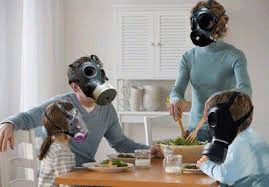Healthy Indoor Air Quality Factors
Because most people spend 80 to 95% of their time indoors, good clean air quality is critical to our well-being. Indoor air quality can be affected by many things:

- The supply of fresh air
- Proper filtering of air flow
- Outgassing from furnishings
- Fumes from chemicals
- Radon
- Combustion gases from gas appliances & heating
- Ozone production from office equipment
- Mold spores
- Pollen
- Animal dander
- Dust and Dust mites
- Tobacco smoke
- Wood Burning
- Fibers from insulation, tiles, acoustic panels
- Other nearby businesses, transportation,etc.
The Importance of Fresh Air for Indoor Air Quality
Perhaps the most important factor to consider in good air quality is a system of supplying clean fresh air to a building. The number of air exchanges per hour is very important and is based on the occupancy per square foot of building. This is often difficult to achieve in a residence where the only way to introduce fresh air may be by opening a window or door. A good way to measure the amount of “fresh” air is by measuring the amount of carbon dioxide present. Typical readings should be less than 1000 parts per million (ppm). At levels above this, occupants will tend to feel sleepy, fatigued and other allergy symptoms are exacerbated. Where the fresh air is coming from is another important factor. Placing the air intake near a road with trucks passing by will introduce fumes into the building.
Carbon Monoxide and Indoor Air Quality
High carbon monoxide levels (>50 ppm) are often encountered in facilities with gas heating. Carbon monoxide not only has severe health effects but is also an explosion hazard. Having carbon monoxide detectors located on every floor is the best prevention.
Volatile Organic Compounds and Indoor Air Quality
Volatile organic compounds (VOCs) can be present ten to thousands times higher inside than outside. Just about everything we bring into a building can outgas (give off) VOCs. VOCs have been found to be irritants to humans, causing respiratory and eye irritation, headaches, dizziness, confusion and asthma attacks.
Often times a synergistic effect is produced by a combination of indoor air pollutants. In addition, some people will be affected and some not at all due to varying sensitivities.
What to do for Healthy Indoor Air
To determine problems with indoor air quality, the complete building system must be considered: the age of the building, furnishings & carpeting; the type and maintenance of the heating and air-conditioning system; any recent flooding or water intrusion; the areas surrounding the facility; the type of machines run within the building; the presence of animals; if anyone smokes; and any chemical introduction including cleaning, painting and repairs. Turn-Key can help.


